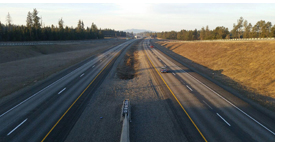

Lack of winter allows ITD northern Idaho crews to get jump
on road striping with new cold-weather paint
For the first time in decades, northern Idaho had nothing resembling its usual winter.
The Coeur d’Alene/Post Falls area had the lowest levels of snowpack and precipitation recorded in years. A half-inch dusting on the last day of February was the only thing that kept that month from being one of the driest winter months on record for the region.
Bonners Ferry set high-temperature records just a few days ago. The forecasts in Sandpoint and St. Maries call for near record high temperatures Friday.
Normal snowfall in northern Idaho is approximately 70 inches during the winter season, and is routinely more than 100 inches. Less than three feet of snowfall has occurred so far this winter in Coeur d'Alene. And most of that came in the last two months of 2014. Temperatures are about 20 degrees above normal at this time of year.
Skiers, snowmobilers, and winter enthusiasts were sorely disappointed. But the early spring also presented an opportunity. For the first time in years, the road was not covered by snow as the calendar hit February.
So rather than plowing snow all spring, District 1 crews took the initiative to get ahead of needed maintenance. With more than 1,500 lane miles of highway in the district, crews seized the chance to get a jump on the striping.
Faded paint stripes on highway are a serious safety issue for drivers each year, particularly after repeated winter plowing scrapes paint off the roadway surface and reduces the delineation, or marking, that motorists rely upon.
Mike Rearden, Striping and Signing foreman, encouraged Mark Thompson, from his crew, to investigate a Wolverine cold-weather latex paint. After several months of investigation, the district started using the fast-drying paint Feb. 25. By contrast, the crew wasn’t able to start using paint last spring until April 29. The old paint required temperatures of 55 degrees and rising, whereas the new cold-weather paint sticks and stays at temperatures of just 35 degrees.
Pictured at left: U.S. 95 from Chilco Interchange near Silverwood after the cold-weather paint was applied.
Crews began by painting a 12-mile seal coat on U.S. 95, with a beginning temperature of 42 degrees. “Upon completion of striping that day, we had very little tracking — if any at all,” explained Thompson.
They completed striping of other seal coats on U.S. 95 and Idaho 200 near Sandpoint at temperatures as low as 37 degrees.
“The use of this paint will increase our efficiency and allow us to stripe more miles by extending our season,” said District 1 Administrative Manager Scotty Fellom. “We’ll be able to get more done to ensure the motoring public’s visibility, which equates to safer roadways.”
“In District 1, we are challenged with working around the weather,” explain Operations Manager Jason Minzghor. “Last year, we started striping on April 29, had to end on Oct. 8 and lost 42 days to weather. With this new paint, we can also stripe late in the season on paving projects, and touch up stripes just before winter.”
Minzghor said District 1 crews use about 60,000 gallons of paint each year to paint new areas and touch up old paint stripes. He said District crews usually can paint for about 160 days during the year, minus the days lost to rain or inclement weather. By using the cold-weather paint, crews can expand the season by about 70 days.
The paint costs only about 30 cents per gallon more than the usual latex paint, but the slight cost increase is more than compensated for. “The paint is not cost prohibitive, and increases our striping season immensely,” said Thompson.
“We are completely amazed at how well this paint performs and are excited to have the opportunity to be the first in District 1 to use this paint,” said Thompson. “We have just ordered another load of each color (white and yellow), and plan to keep using this paint as much as possible, and to continue testing its lower application temperatures.”
“We have yet to encounter any problems, such as plugging the truck or clogged totes. This paint clearly outperforms any other latex paint we have used. It gives us a huge advantage by allowing us to get to the areas of our district sooner that have trouble retaining stripes,” Thompson added.
“I am proud of our dedicated striping crew for finding new products to better serve the traveling public, making our roads safer by getting a two-month head start on the striping season,” Minzghor said.
Published 03-13-15